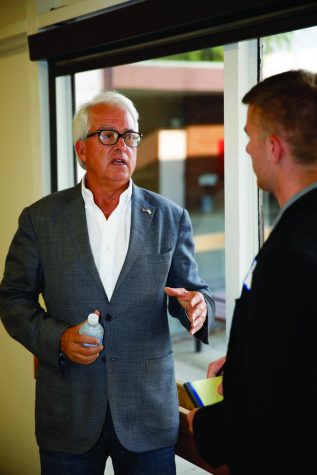Cox vs. Newsom
A race for leadership in California begins
Shiny Things/ Creative Commons
Newsom sells himself on being able to uphold the virtues of diversity in California.
The time draws near for the actual midterm elections, and the race grows ever more intense. However, these elections aren’t just about the seats in Congress or the Propositions. One of the finer parts of the midterm elections are the governor’s race.
This year particularly, the Gubernatorial elections in California seems to add fuel to the fire that is the modern American political climate. The contest is between Democratic candidate Gavin Newsom and Republican candidate John Cox. In this case, neither candidate is an incumbent, which means both will be new to the position of state governor. It is a chance for the whole state to have a fresh pair of hands working on its issues.
The importance of this election comes from the power that the governor’s seat brings. As with federal government, each of the fifty states have its own three branches of government, but on a smaller scale.
The governor is thus the executive figure and the commander-in-chief on the state level. To simplify a very complex job, the governor is the equivalent of state president. As such, he receives the ability to sign or veto state legislature bills, to serve as the commander-in-chief for the state’s military forces, and to appoint state court judges.
Newsom wishes to use this power in a campaign to uphold what he has dubbed “Californian values.” He has built his election around this concept, a set of values generated by a set of demands for social justice.
These virtues, according to Newsom, include elements such as celebrating diversity, advancing LGBTQ equalities, protecting immigrant families, closing the pay gap, and stopping the NRA from having political influence, among many other elements.
Indeed, it is made clear that Newsom is selling himself on the ground of social rights issues. His other most vocal election topic is universal health care for all Californians, no matter their citizenship status.
Newsom believes this can be done by switching to a single-payer healthcare program, where individual insurance agencies are replaced with a single, non-profit public payer agency, that is supported by taxes. As often is the case, detractors of this plan argue that Californians cannot afford any more heavy taxations, citing California’s high-income tax and the highest-in-the-nation sales tax rates.
Of course, Newsom supporters argue that he has strong backing due to his experienced political career. Prior to his bid as California governor, Newsom acted as the lieutenant governor and before that, the mayor of Sacramento. These are factors that further pitted Newsom against President Trump, who took multiple chances to attack the candidate and his policies.
On the other side of the ring is John Cox. Cox sets up a strong contrast between him and his opponent by being a complete outsider to the California political system. He has repeatedly dabbled in Illinois politics, although he never managed to actually complete any race he took part in.
He got involved in California politics in 2016, when he tried to pass the “California is Not for Sale” initiative, which would require legislators to wear the logos of their top 10 financial backers, just like Nascar drivers do. The initiative did not go through.
Cox runs his platform on being “one of the people.” His primary focuses for the duration of the election have been the housing crisis and the gas prices in California. His policies focus on lambasting Newsom’s strategies and how ineffective they will be.
One such focus is Newsom’s healthcare plan, which Cox criticizes as “turning healthcare over to the DMV,” saying that if an agency like the DMV managed healthcare, the process would become exponentially more complicated and slow. However, Cox offers little in the form of counter solutions, only saying that he will work to provide better healthcare, housing, repeal the gas tax, etc.
While those who like Cox argue that his deconstruction of Newsom’s ideas is solid ground, others believe that his lack of solutions proves him the weaker candidate. This is further supported by Newsom having a 20 point lead in most election polls. Still, Cox persists that Newsom is a representation of a corrupt leader who proposes ideas that are too expensive for the state of California.
The election seems to sway in favor of Newsom, which would mean another defeat for Cox. However, if the last presidential election proved anything is that appearances can be deceiving. Only time can tell who will be victorious.



